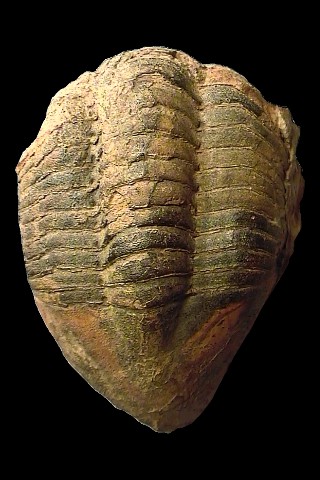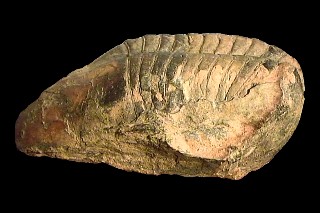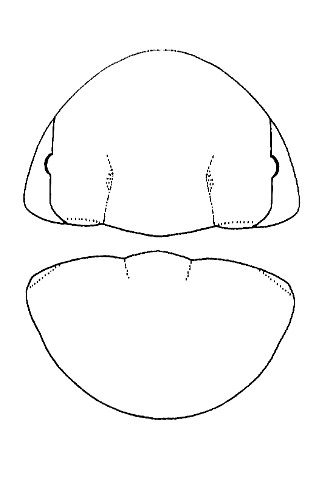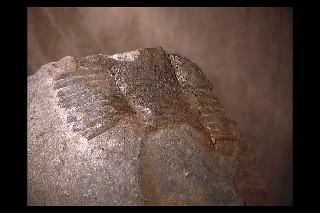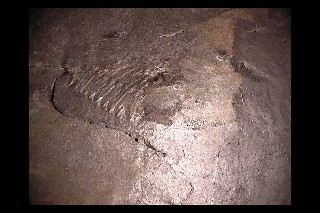Ectillænus giganteus
Here is a trilobite collected in France, famous in Brittany and Spain. This
specimen has an unusual transversal curve, moreover when one know that this
trilobite is frequently found strongly distorted, when not totally flat. (cf.
infra). This specimen does indeed himself suffer a transversal distortion
that let it symetrical, bending him transversaly.
We remind that the appearance of trilobites may strongly differ from one specimen
to another simply because of tectonic distortions, but this is related to sediments
too. The specimes herein reported collected in the ardoisières de La
Pouëze are strinking examples of very different conservation modes.
|
|
Description du spécimen
- Partially enrolled trilobite..
- on a piece of matrix.
- Small right eye.
- Thoracic rings perfectly preserved, transversally bent (tectonic
distortion)
- Total size : 105 mm (75 mm)
- Middle Ordovician (Llandeilo).
- Normandy.
- France.
- NB : The anterior part of the cephalon presents cuticular ridges
hardly visible on pictures.
|
|
|
Right lateral view.
|
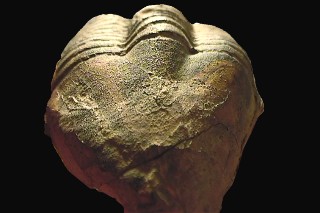 |
|
Dorsal view
|
Posterior view.
|
DIAGNOSE
|
Order
|
Corynexochida
|
KOBAYASHI 1935 |
Occurrence: Lower Cambrian – Middle Devonian
- Cephalon: Opisthoparian sutures.
- Glabella elongate, sides often concave (pestle-shaped).
- Furrows (when not effaced) typically with splayed arrangement, the
hind pair pointing sharply backwards. Anterior pairs tending more and
more forward directed. Sometimes furrows pit-like.
- Cranidial borders often ledgelike.
- Hypostome conterminant or (in derived forms) impendent.
- Eyes typically large, in some gently arcuate
- Thorax: typically with 7-8 segments (but range for order is
2-12, rarely more).
- Pleural tips often spinose.
- Pygidium : typically large (isopygous or subisopygous).
- Variable form.
- Some spinose.
|
|
Suborder
|
Illænina
|
JAANUSSON 1959 |
Occurence : Upper Cambrian Devonian.
- Cephalon : Typically effaced.
- Doublure broad.
- Opisthoparian facial sutures.
- Sutures distinctly diverging anteriorly.
- Glabella expanding forwards.
- Lateral furrows often faint or absent.
- 4 pairs of glabellar furrows, commonly faint or absent.
- Extra-axial cephalic muscle impressions (lunette) present.
- Eyes frequently on the posterior part of the genæ, close to
the axial furrows.
- Terrace lines frequent, particularly at the distal ends of the thoracic
exoskeleton and the ventral doublure.
- Hypostome impendent (conterminant, but hypostome no longer matching
anterior glabellar border)
- Rostral plate limited by sutures, fused in the late species of Panderia.
- Trilobitation frequently fainting .
- Thorax : 8-10 segments.
- Pygidium : Isopygous or subisopygous.
- Rounded posteriorly.
- Usually with short axis.
|
|
Superfamily
|
Illænoidea |
HAWLE & CORDA
1847 |
|
| Family |
Illænidæ |
HAWLE &
CORDA 1847 |
- Cephalon : Axial region of cephalon smooth, merging forward
into frontal area without boundary.
- 4 pairs of muscle scars can be observed instead of glabellar and occipital
furrows.
- Glabella strongly convex.
- Opisthoparian facial sutures.
- Rostral shield broad (tr.).
- Hypostoma oval, with elongated body (sag.)
- Anterior wings of hypostoma broad, quadrangular.
- Pygidium : Axis and pleural field smooth or with very faint
traces of unfurrowed ribs.
- Surface ornemented with terrace lines or small pits, or both.
- No tuberculate or granulose ornementation.
|
| Genus |
Ectillænus (= Wossekia)
|
SALTER 1867 |
- Cephalon : Dorsal furrows almost rectilinear.
- Eyes very small or absent.
- Post-ocular branches of the facial sutures curved at their posterior
end.
- Subtriangular hypostoma.
- Anterior border of the hypostoma almost transverse or slightly bent
forward in its central part.
- Anterior wings broad and short.
- Thorax : 10 segments.
- Axis well defined.
- Pygidium : About half of the cephalon's length (sag.)
- Doublure as long as 30 to 50 % of the pygidium total length (sag.)
|
| Species |
giganteus |
BURMEISTER 1843 |
Large sized isopygous form (up to 30 cm).
- Cephalon : parabolic.
- Almost smooth.
- 5 faint pairs of muscle scars (see below)
- Dorsal furrows faint, completely fainting exsagittally at the anterior
half.
- Very small eyes, located at the posterior part of the cranidium.
- Librigenæ narrow and subtriangular.
- No genal spines.
- Cephalic doublure broad with concentric terrace lines.
- Rostral plate of large size, semilunar, with transverse sutures.
- Hypostoma quadratic with subtriangular body, sharp and covered with
terrace lines.
- Anterior wings broad (tr.), quadrangular.
- Cephalic angle : 80 to 85°.
- Thorax : 10 segments
- Quadratic rings, as wide as the third of the total width.
- Smooth pleuræ, bearing a geniculation at mid-length.
- Pygidium : slightly ogival, almost circular.
- Axis hardly distinct.
- Pygidial angle : 110 to 120°
|
Complementary pictures :
 |
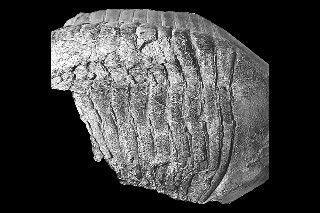 |
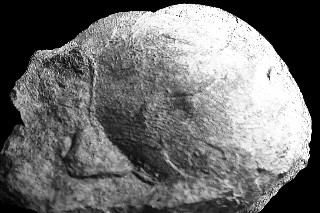 |
|
Cephalon, dorsal view
|
Géniculations à mi-longueur des plèvres.
|
Terrasses cuticulaires céphaliques.
|
Scroll over the central picture to see the
pleural geniculation
- Note the characteristic dorsal furrows on the cephalon and the
terrace lines on the broad cephalic doublure.
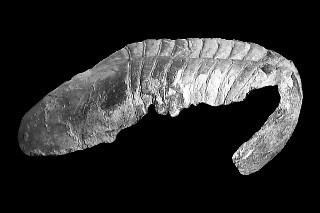 |
|
Partial enrollment. Cephalon is on the right of the
picture.
|
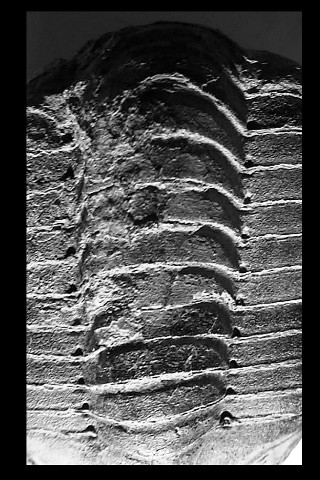 |
|
Details of the thoracic axis. Note the deep perforations.
|
|
|
|
Synthethogram of Ectillænus giganteus.
(After P. Lebrun, 2001)
|
Discussion and remarks :
Following RÁBANO & GUTIERREZ
(1983), one will note that E. bituberosus KNUPFER
1967 and E. convergatus KNUPFER 1967 of Thuringia
(Germany) are no more assigned to the genus Ectillænus.
RÁBANO & GUTIERREZ (1983)
precised the diagnose of Ectillænus giganteus with measurements
that are sadly frequently useless due to tectonic distortions. They consist
in the angle measured between 2 sagital tangents (the tangents to the anterior
border and to the occipital ring for the cephalic angle, and the tangents to
the proximal part of the axis and to the border for the pygidium). They included
in the diagnose the description of the muscular impressions that I write down
only here (they are almost never seen, being situated in the inner face of the
cranidium) :
- I : (posterior) : small and subcircular.
- II : semicircular, in the inflexion point of the dorsal furrows.
- III : large and "inverted J" shaped.
- IV : subtriangular.
- V : very narrow (exsag.) and slightly converging posteriorly.
Ectillænus has been found in Iberic Peninsula, in France, in Great-Britain,
in Bugaria, in Morocco, in Central Asia (?) and in Sweden (?).
A few other specimens (La Pouëze,
Maine-et-Loire, France).
Back to
Home Page
